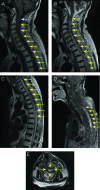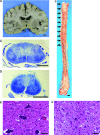Posterior spinal artery syndrome showing marked swelling of the spinal cord: a clinico-pathological study
- PMID: 23433332
- PMCID: PMC3555103
- DOI: 10.1179/2045772312Y.0000000017
Posterior spinal artery syndrome showing marked swelling of the spinal cord: a clinico-pathological study
Abstract
Objective: To describe a rare autopsy case of posterior spinal artery syndrome with marked swelling of the spinal cord, an unusually subacute onset and short clinical course.
Methods: Case report.
Findings: An 84-year-old Japanese woman presented with bilateral muscle weakness of the lower legs and sensory disturbance 1 week after head contusion. Neurological findings worsened gradually. She developed phrenic nerve paralysis and died of respiratory failure 6 weeks after the onset of neurological symptoms. On pathological examination, the spinal cord was markedly swollen in the cervical and upper thoracic segments. Microscopically, there was loss of myelin sheath in the bilateral posterior columns and neuronal loss of the posterior horns in all of the spinal segments. However, findings were unremarkable in the bilateral anterior columns and bilateral anterior horns in most of the spinal segments. Posterior spinal arteries had no stenosis, occlusion, or thrombosis. We considered that pathogenesis was infarction associated with head injury.
Conclusion: To our knowledge, this is the first report of a case of posterior spinal artery syndrome with a markedly swollen spinal cord and poor prognosis.
Figures


Similar articles
-
Vascular mechanisms in the pathophysiology of human spinal cord injury.J Neurosurg. 1997 Mar;86(3):483-92. doi: 10.3171/jns.1997.86.3.0483. J Neurosurg. 1997. PMID: 9046306
-
A case of posterior spinal artery syndrome in the cervical cord: a review of the clinicoradiological literature.Intern Med. 2012;51(7):803-7. doi: 10.2169/internalmedicine.51.6922. Epub 2012 Apr 1. Intern Med. 2012. PMID: 22466844 Review.
-
Pediatric cervical kyphosis in the MRI era (1984-2008) with long-term follow up: literature review.Childs Nerv Syst. 2022 Feb;38(2):361-377. doi: 10.1007/s00381-021-05409-z. Epub 2021 Nov 22. Childs Nerv Syst. 2022. PMID: 34806157 Review.
-
[An autopsy case with subacute spinal cord disease showing progressive paraplegia].No To Shinkei. 2002 Jun;54(6):543-9. No To Shinkei. 2002. PMID: 12166108 Japanese.
-
Spinal tanycytic ependymoma with hematomyelia--case report--.Neurol Med Chir (Tokyo). 2005 Mar;45(3):168-71. doi: 10.2176/nmc.45.168. Neurol Med Chir (Tokyo). 2005. PMID: 15782011
Cited by
-
Spinal cord infarction in a young patient with methamphetamine abuse.BMJ Case Rep. 2021 Mar 30;14(3):e241031. doi: 10.1136/bcr-2020-241031. BMJ Case Rep. 2021. PMID: 33785605 Free PMC article.
-
The etiologies and prognosis associated with spinal cord infarction.Ann Clin Transl Neurol. 2019 Aug;6(8):1456-1464. doi: 10.1002/acn3.50840. Epub 2019 Jul 15. Ann Clin Transl Neurol. 2019. PMID: 31402616 Free PMC article.
-
Spinal Cord Infarction Mimicking Acute Transverse Myelitis.Cureus. 2017 Dec 6;9(12):e1911. doi: 10.7759/cureus.1911. Cureus. 2017. PMID: 29441246 Free PMC article.
-
Clinical biomarkers differentiate myelitis from vascular and other causes of myelopathy.Neurology. 2018 Jan 2;90(1):e12-e21. doi: 10.1212/WNL.0000000000004765. Epub 2017 Dec 1. Neurology. 2018. PMID: 29196574 Free PMC article.
-
Visualization of the Spinal Artery by CT During Embolization for Pulmonary Artery Pseudoaneurysm.Pol J Radiol. 2016 Aug 15;81:382-5. doi: 10.12659/PJR.897975. eCollection 2016. Pol J Radiol. 2016. PMID: 27617047 Free PMC article.
References
-
- Hegedüs K, Fekete I. Case report of infarction in the region of the posterior spinal arteries. Eur Arch Psych Neurol Sci. 1984;234(4):281–4 - PubMed
-
- Williamson RT. Spinal softening limited to the parts supplied by the posterior arterial system of the cord. Lancet. 1895;2(3757):520–1
-
- Chung MF. Thrombosis of the spinal vessels in sudden syphilitic paraplegia. Arch Neurol Psychiatry. 1926;16(6):761–71
-
- Henneberg R. Reine vaskulare, spinale Lues. Berl Klin Wochenschr. 1920;57(43):1026–32
-
- Hinrichs U. Myelodegeneratio non specifica bei Luikern. Dtsch Z Nervenheilkd. 1928;106(1–6):1–12
Publication types
MeSH terms
LinkOut - more resources
Full Text Sources
Other Literature Sources
Medical
